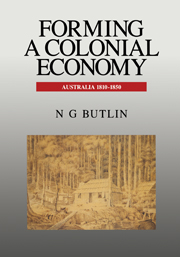Book contents
- Frontmatter
- Contents
- List of Tables
- List of Figures
- Acknowledgements
- Part I Forming an Economy
- Part II The Colonial Peopling of Australia: 1788–1850
- Part III Public Funding of Colonial Development: 1788–1850
- Part IV The Colonial Australian Economy 1810–1840—A Historical, Statistical and Analytical Account
- 11 Summary and Questions
- 12 Towards a Private Market Economy in Australia: 1810–40
- 13 Structural Adjustment and Development: 1810–40
- 14 Growth Performance: 1810–40
- 15 Instability and Economic Fluctuations with Special Reference to the Depression of the 1840s and Recovery
- Bibliography
- Appendixes
- Index
12 - Towards a Private Market Economy in Australia: 1810–40
from Part IV - The Colonial Australian Economy 1810–1840—A Historical, Statistical and Analytical Account
Published online by Cambridge University Press: 04 August 2010
- Frontmatter
- Contents
- List of Tables
- List of Figures
- Acknowledgements
- Part I Forming an Economy
- Part II The Colonial Peopling of Australia: 1788–1850
- Part III Public Funding of Colonial Development: 1788–1850
- Part IV The Colonial Australian Economy 1810–1840—A Historical, Statistical and Analytical Account
- 11 Summary and Questions
- 12 Towards a Private Market Economy in Australia: 1810–40
- 13 Structural Adjustment and Development: 1810–40
- 14 Growth Performance: 1810–40
- 15 Instability and Economic Fluctuations with Special Reference to the Depression of the 1840s and Recovery
- Bibliography
- Appendixes
- Index
Summary
Introduction
By 1810, only a very small number of persons, whether convict or free, had been transferred to Australia. The great inflow of immigrants occurred after 1812, in broad terms accelerating up to 1840 when a sharp reversal occurred. Although the initial bridgehead to 1810 was strongly influenced by British ideas, behavioural practices and institutions, the mass transfer, the mass influence of Britain on Australia during this formative period, occurred after 1810. Though major adaptations in Britain, encapsulated in the concept of the Industrial Revolution, may have influenced the decision to establish a penal colony in Australia, it was after 1810 that the full flow of these British changes affected the colonies.
Historians are accustomed to the idea of the ‘intellectual baggage’ that came with these immigrants. What has not been explored adequately is the content of this ‘baggage’ and the way in which it was adapted to Australian conditions. This section addresses these issues. Immigrants to Australia, whether coerced or not, came with various parts of an understanding of how the British economy and British society operated. This implied a degree of understanding of the most advanced market system on earth. It is clear that, during the years of establishing a bridgehead, officials, both military and civil, had a strong appreciation of self-interested behaviour, of the value of private property, of the importance of accumulation and incentive. Subsequently, freely arriving immigrants were similarly attuned to market behaviour.
- Type
- Chapter
- Information
- Forming a Colonial EconomyAustralia 1810–1850, pp. 107 - 136Publisher: Cambridge University PressPrint publication year: 1994



